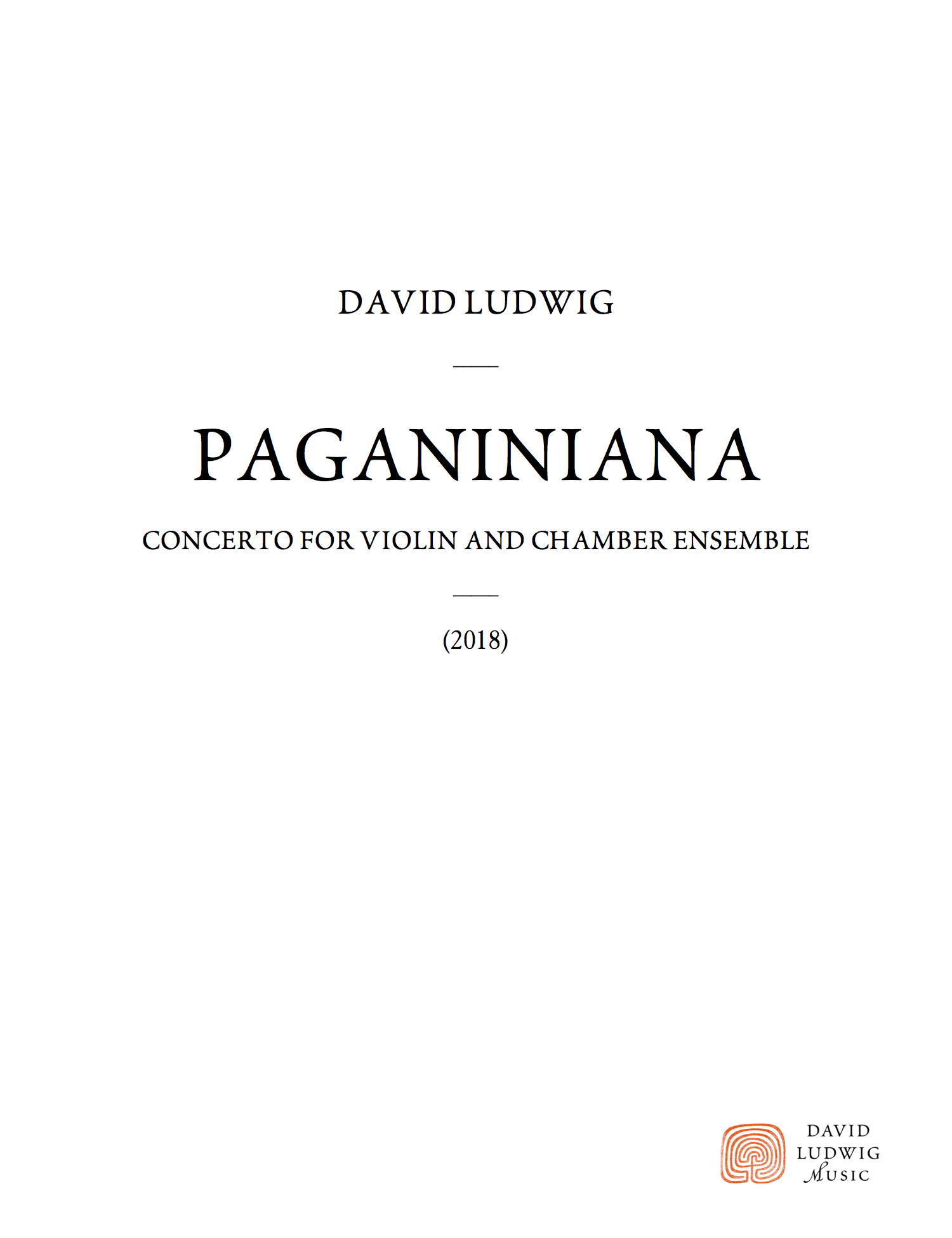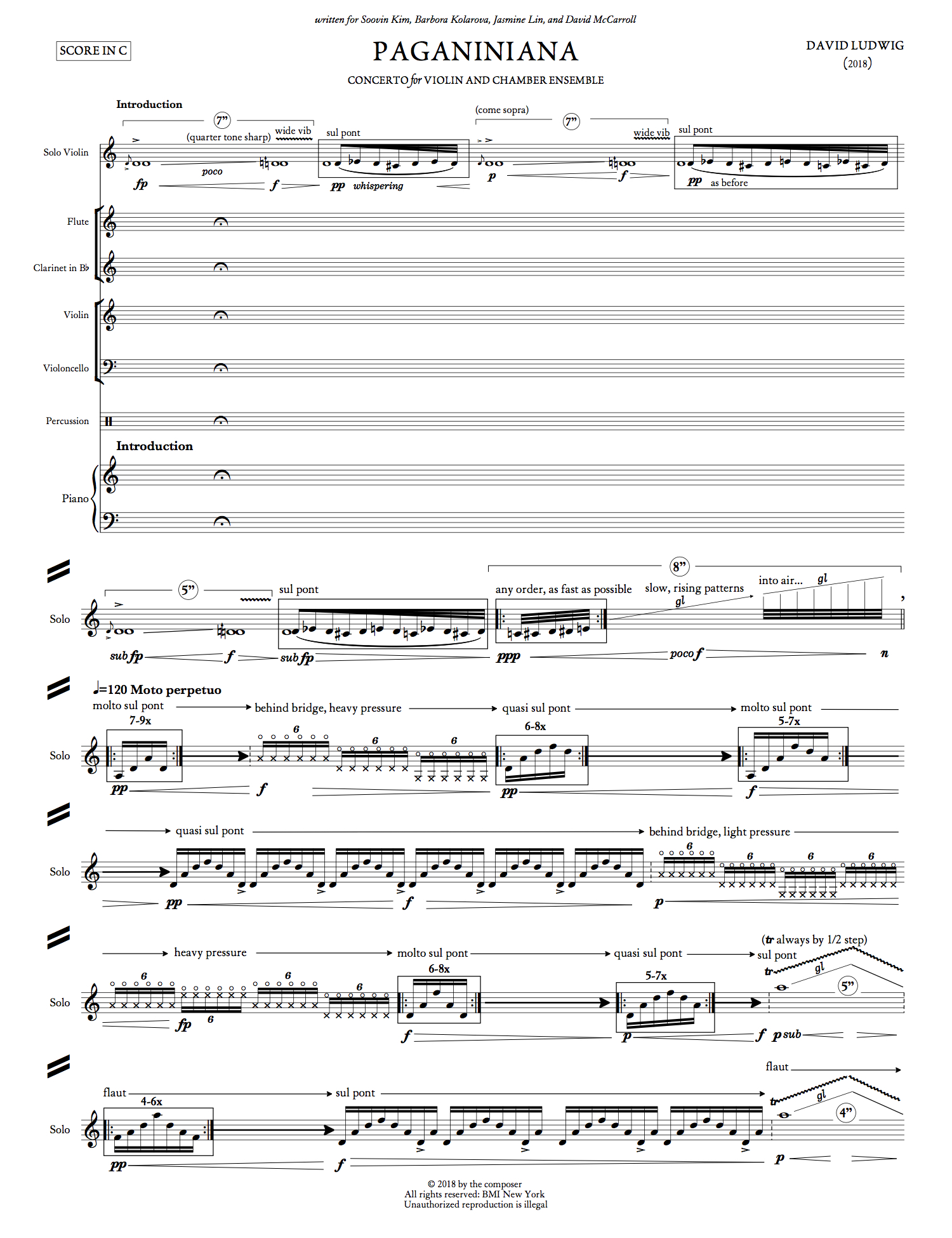

Paganiniana
Violin Concerto No.2 (2018) for violin and chamber ensemble - 18'
- solo vln, fl, cl, vln, vcl, pno, perc
- Commissioned by Portland Chamber Music Festival, Kingston Chamber Music Festival, Lake Champlain Chamber Music Festival, and Lake George Music Festival
- Written for Soovin Kim, Jasmine Lin, Barbora Koarova, and David McCarroll
Rental Information
Program Notes
The four music festivals that commissioned Paganiniana were all founded by terrific violin players, and that fact made me think immediately of Niccolò Paganini. The concerto is set in a single movement, divided into three sections, and written as a fantasy that follows the path of each of Paganini’s Caprices, one after the next like a continuous set of variations on the entire collection, running parallel but two centuries apart.
There are a few quotations from the caprices: some hidden, some in plain view and tongue-in-cheek—and all with a nod to the violinist-composer’s brilliance, charm, and virtuosity.
The soloist is asked to explore most every aspect of virtuosity, from fast arpeggios to long, held melodic lines, and to extract a wide variety of strident sounds and colors from the violin through extended techniques.
Paganiniana was commissioned by the Lake Champlain Chamber Music Festival, the Lake George Music Festival, the Portland Chamber Music Festival, and the Kingston Chamber Music Festival.
Press
“Composer David Ludwig has a distinguished lineage — his grandfather was pianist Rudolf Serkin, and his great-grandfather was violinist/conductor Adolf Busch.
Ludwig’s “Paganiniana,” a world premiere performed Sunday afternoon at the Kingston Chamber Music Festival at the University of Rhode Island, continued that lineage, making new connections as well.
Those connections — one can guess — explored the legacy of violin virtuoso Niccolò Paganini. Ludwig’s concerto, performed here by soloist Jasmine Lin and a small ensemble, invoked the virtuoso’s spirit.
In one continuous movement, but encompassing many moods, Ludwig’s work recalls Paganini’s great set of Caprices. While echoes of that work abound — especially the alluring 24th Caprice — it’s more the legend of the virtuoso that informs the music.
Lin’s strengths made the work come to life. Possessed of formidable bowing technique, she made the treacherous passages seem lively and flowing, the lyrical passages deeply felt.
Ludwig’s work begins with a solo cadenza, sounding like the religious minimalism of Arvo Pärt, with its repetitions and challenging intervals. The ensemble was heavy on percussion — Mari Yoshinaga played an array, including marimba, gongs, snares and blocks, and pianist Natalie Zhu added percussively, even reaching into the instrument for strumming effects.
The solo techniques focused on bowing, with Lin playing in front, on top and behind the bridge — each effect creating a different sound world.
“Paganiniana” pivots around Lin’s cadenzas. The first — showy but accessible — opens the work, and later returns. Others interrupt the ensemble in various ways — one lyric and mellow, and another, at the end, strongly evoking the 24th Caprice. The work felt organic and genuine; here’s hoping Lin keeps it in her repertory and realizes many more performances.” - Providence Journal (Read the full review here.)
~
“The concert’s forepart concluded with Paganiniana a new work by David Ludwig, which was on the second stop of its premiere tour, having been co-commissioned by PCMF and three other festivals. Ludwig, who introduced it from the stage, has made a name for himself with some strikingly affective pieces…and this one, a virtuoso showpiece (you doubtless guessed that from its name); he bills it as a concerto for violin (McCarroll) and chamber ensemble (Laura Gilbert, flute; Todd Palmer, clarinet; Elowitch, violin; Brant Taylor, cello; Diane Walsh, piano; and Robert Schulz, percussion). The idea was to take Paganini’s famous 24 Caprices, distill them into their technical and gestural essences, apply these to a contemporary sound world, while retaining the charm and magic (and sometimes the notes) of the originals. It is organized into one movement of three fairly distinct sections corresponding to a standard concerto. We didn’t attempt to dig deeper into its formal structure, partly because we were entranced and frankly awed by the brilliance with which McCarroll nailed both its prodigious technical requirements and the channeling of the charisma and ferocity of Paganini’s rock-star persona. Of the many felicities in this piece, the use of piano and percussion to spur the obsessive propulsion of the writing, even through the slower central section, especially impressed. Unlike a lot of other composers, Ludwig has a good sense of how a piece should end. In this case, the end must needs deal with the final caprice, one of the most famous and protean tunes, which has generated variation sets not only by Paganini but by Schumann, Brahms, Rachmaninoff, Lutosławski, and who knows how many others. Here, Ludwig wittily provides the lightest, wispiest acknowledgment, enough to let you recognize it, and then zips to the end. We loved it.” - Boston Musical Intelligencer (Read the full review here.)
~
“As alluded to in the concert’s name, the evening also featured the world premiere of David Ludwig’s “Paganiniana,” Concerto No. 2 for Violin and Chamber Ensemble. Ludwig, chair of the composition department at the renowned Curtis Institute of Music in Philadelphia, is an engaging and personable public speaker. His pre-concert talk, ably hosted by URI faculty member Mark Conley, provided relevant information about the composition, while avoiding dense musical jargon and vague academic designations.
In “Paganiniana,” Ludwig tells the story of the gifted and troubled violin virtuoso Niccolò Paganini through a stylistic tour de force that quotes all 24 of Paganini’s famed Caprices. Ludwig claimed Paganini was the first rock star – a designation probably more fitting for Franz Liszt – and cleverly drew comparisons between Paganini and rock icons, saying that Paganini shredded like Jimi Hendrix and dressed like Spinal Tap. He comfortably answered questions from the audience, giving a glimpse into his compositional process and stressing the importance of communicating emotionally with audiences.
If there was any uncertainty that Ludwig’s “Paganiniana” was going to live up to its Hendrix-meets-Paganini billing, doubts abated as the stage crew began the elaborate setup for the seven musicians. Aside from the traditional Pierrot ensemble – a sextet formation modeled on the instrumentation of Arnold Schoenberg’s “Pierrot Lunaire” – Ludwig included a percussion part that required, among other things, castanets, a gong, tom-toms and a suspended cymbal. The seven musicians were surrounded by conspicuous recording equipment as well, adding palpable gravitas to the premiere.The piece began with a solo cadenza, executed in true rock-star fashion by Grammy-nominated violinist Jasmine Lin. After an introduction featuring microtonal slides that evoked pre-performance tuning rituals, Lin launched into a string-crossing, arpeggiated barrage punctuated with dizzying slides and sound effects akin to whinnying horses.
The ensemble’s entrance did nothing to slow the eclectic unfolding of sounds; Lin’s virtuosity remained the unifying constant through the glorious and erudite patchwork of musical moments that were at times reminiscent of Schoenberg’s 12-tone compositions, Stravinsky’s “Soldier’s Tale,” Bernstein’s “West Side Story,” the theme song from “The Twilight Zone” and countless other musical sound worlds.
Fittingly, the piece ended with a recognizable quotation from the 24th Caprice, which elicited knowing chuckles from the audience. The ensemble deserves tremendous credit for expertly performing the piece with what Zhu said was approximately four hours of rehearsal time.” - The Independent (Read the full review here.)
